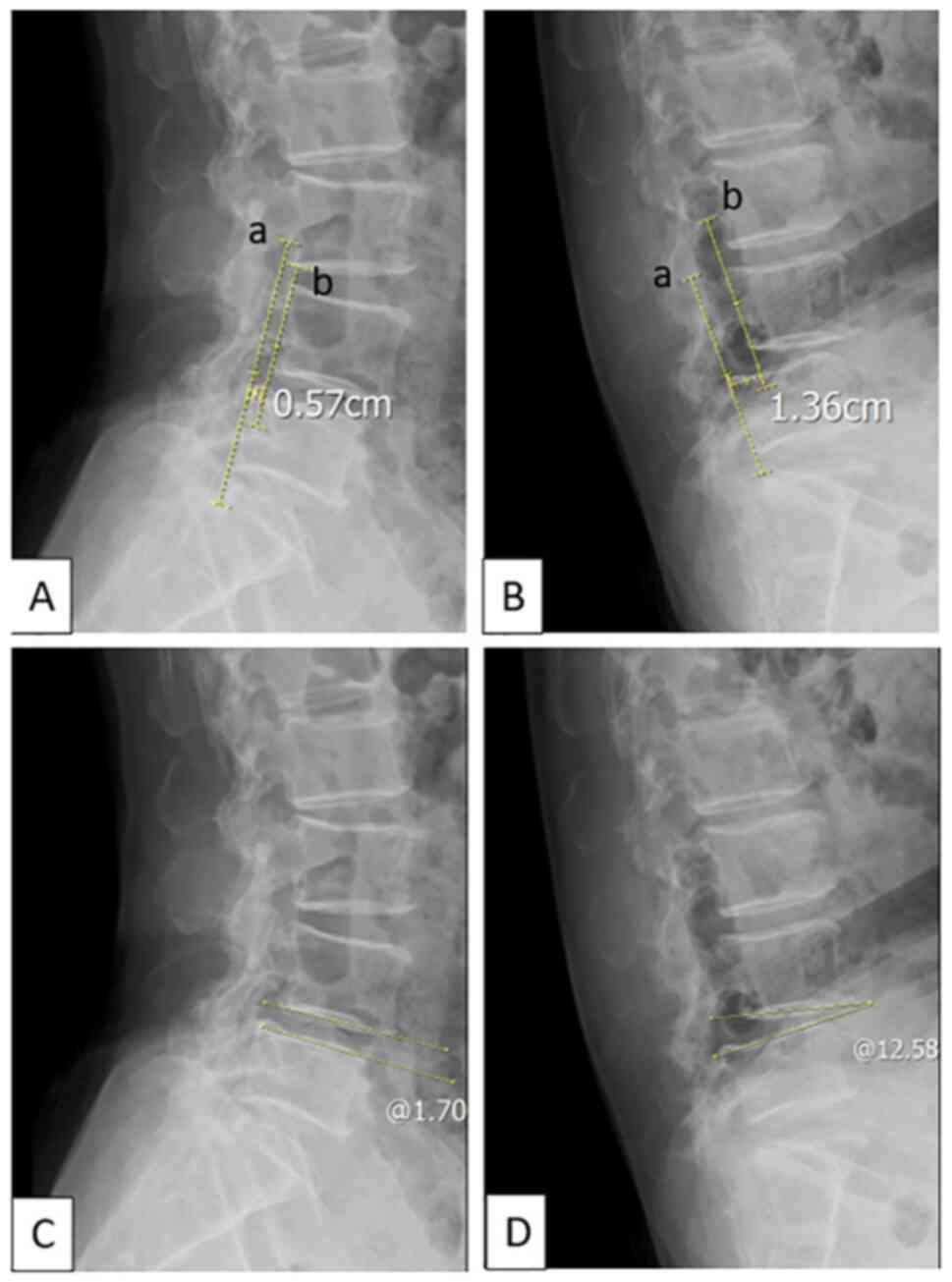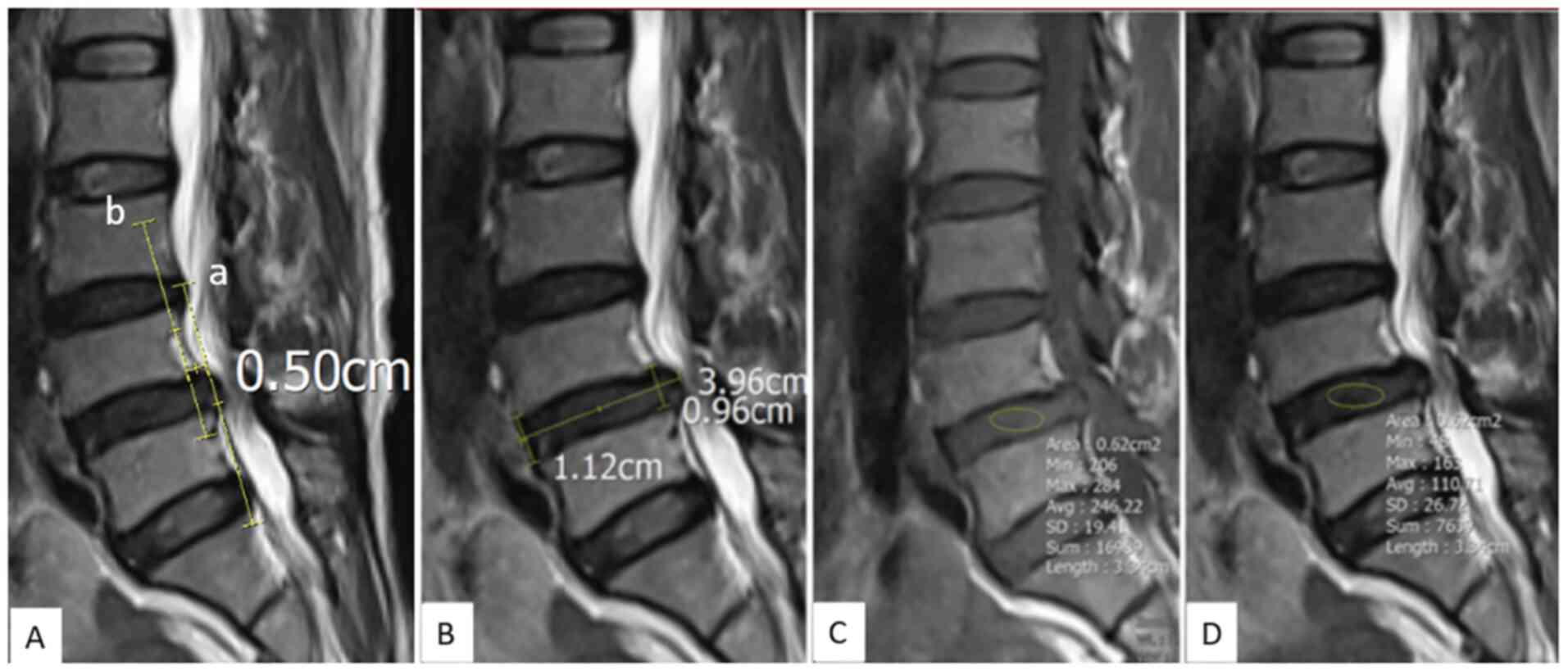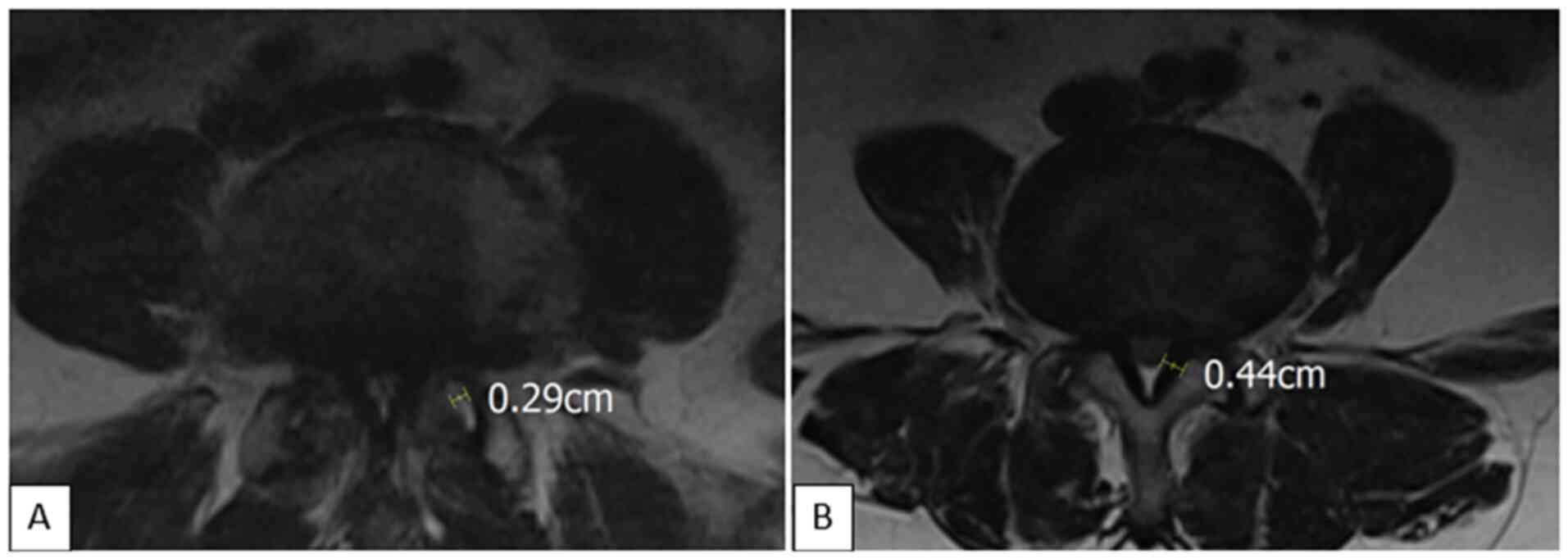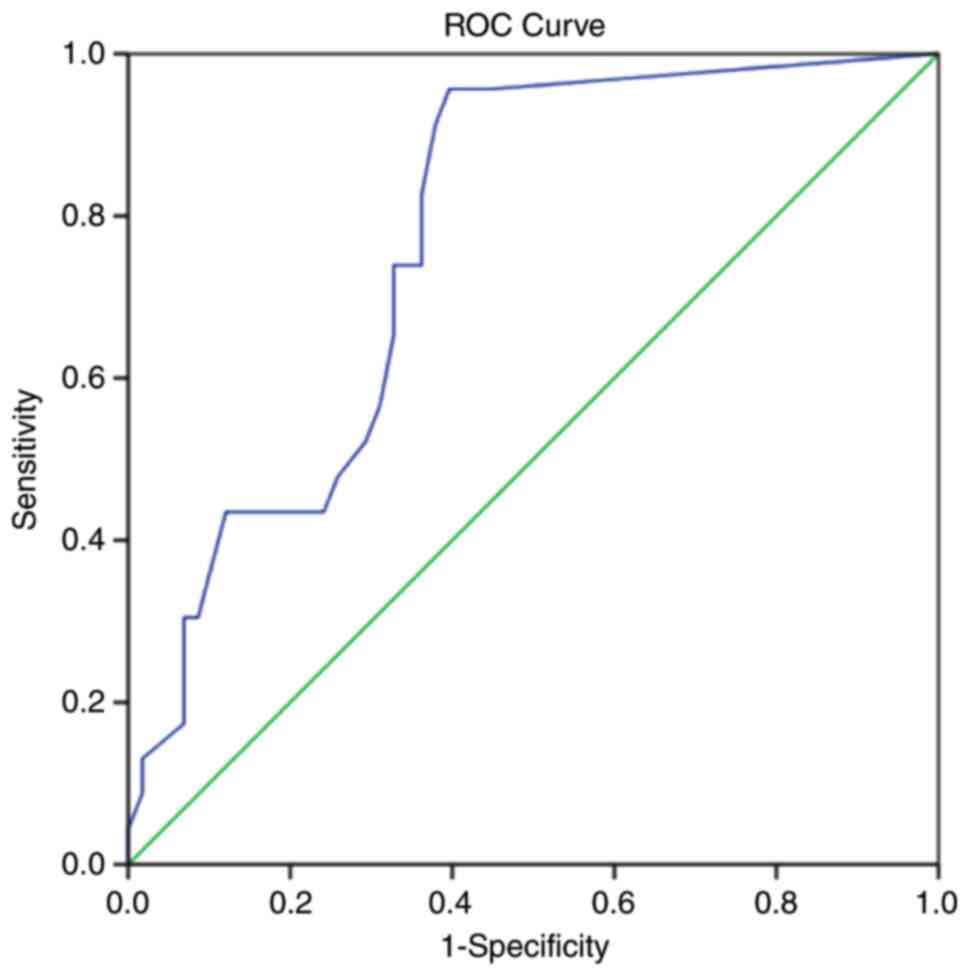The efficacy of quantitative magnetic resonance imaging in the diagnosis of unstable L4/L5 degenerative spondylolisthesis
- Authors:
- Published online on: June 8, 2022 https://doi.org/10.3892/br.2022.1550
- Article Number: 67
-
Copyright: © Hung et al. This is an open access article distributed under the terms of Creative Commons Attribution License.
Abstract
Introduction
Lumbar degenerative spondylolisthesis (LDS) is defined as the excessive displacement of one vertebral body relative to another due to degenerative changes in spinal support structures, such as disks, ligaments, and facet joints (1-3). LDS can occur in any segment of the spine but is most commonly found in the L4/L5 segment, which may be due to the large range of flexion-extension motion that involves this segment (3,4). Lumbar instability refers to any abnormal movements of the spine beyond its normal range. Mechanical instability due to spinal degeneration can cause clinical symptoms, such as back pain or nerve compression, presenting as leg pain, leg weakness, and cauda equina syndrome (1,5,6). When clinical symptoms worsen, surgical treatments should be considered. Early and accurate diagnosis can promote the initiation of appropriate treatment strategies and improve clinical outcomes in this patient population. The treatment strategies include surgery with decompression or decompression with fusion and conservative treatment (7,8). Standing lateral flexion-extension (SLFE) radiographs are used as the gold standard for diagnosing spinal instability (1,2,5). Previously, several studies have reported that disk degeneration and signs of facet joint effusion detected on T2-weighted (T2W) MRI can be indicators of potential lumbar spine instability (8,9). However, qualitative MRI evaluations are highly dependent on the subjective judgments of the radiologist. In this study, quantitative value assessments including disk height, facet fluid thickness, ligamentum flavum thickness, and disk signal intensity on T1-weighted (T1W) and T2W MRI were assessed to identify potential factors and their efficacy in the diagnosis of unstable L4/L5 degenerative spondylolisthesis.
Materials and methods
Study subjects
A retrospective study was conducted on 81 patients (age range, 39 to 85 years old, median age, 59 years old) diagnosed with L4/L5 LDS based on X-ray and MRI evaluations at the Viet Duc Hospital between January 2021 and January 2022. The patients were divided into 2 groups, the stable group (SG) which included 39 women and 19 men and the unstable group (UG) which included 20 women and 3 men. The institutional review board of Hanoi Medical University approved this retrospective study (approval no. 2444/QĐ-ĐHYHN, dated 13 July 2021). Due to the retrospective nature of this study, the requirement for informed consent was waived by the institutional review board of Hanoi Medical University. The study was performed in accordance with the ethical standards of the responsible committee on human experimentation and in line with the guidelines described in the Declaration of Helsinki 1975, as revised in 2013(10). All patients underwent 4 postural lumbar spine X-rays and lumbar spine MRI with basic pulse sequences. Exclusion criteria included spondylolisthesis with trauma, tumor, infection, spondylolysis, surgical history, and congenital hypoplasia of the joints.
Plain film technique
X-rays of the lumbar spine were obtained for all cases in 4 positions: anteroposterior, lateral, maximal flexion, and maximal extension while standing. X-rays were performed using GE Definium XR120 (75-80 kV, 20-25 mAs, 100 cm).
MRI technique
All MRI scans were performed using either a Siemens 1.5 T Magnetom Essenza (Siemens Healthineers) or a Philips Ingenia 1.5 T (Philips Medical Systems) using basic sequences, including sagittal T1W, sagittal and axial T2W, and coronal short tau inversion recovery. The parameters of these sequences are described in Table I.
Image analysis
X-rays and MRI data were stored using the INFINITT PACS system (INFINITT Healthcare) and analyzed retrospectively by a radiologist with >10 years of experience with musculoskeletal imaging.
The Tailliard method was used to measure the slip distance on dynamic radiographs and MRI (11): The first line passes through the dorsal edges of the L5 vertebral body (line a), whereas the second line passes through the lower posterior margin of the L4 vertebral body and is parallel to the first line (line b). The distance between two lines where they pass through the upper ends of the lower vertebra is recorded as the slip distance (Figs. 1 and 2).
On dynamic radiographs, dynamic translation is calculated as the difference in displacement distance between maximal flexion and maximal extension in the same position; angular displacement is calculated as the difference in angle between the lower ends of the L4 vertebral body and the upper ends of the L5 vertebral body comparing maximal flexion and maximal extension in the same position (Fig. 1). Dynamic translation >5 mm or angular displacement >10˚ is defined as an unstable vertebral body slip (12-15). Based on these criteria, the study subjects were divided into two groups: The UG and the SG.
The disk height was determined by calculating the Farfan Index, as the sum of the anterior and posterior border heights divided by the disk width as measured on the sagittal plane of T2W images (Fig. 2) (16). Facet fluid was measured perpendicular to the joint at the site of greatest volume on axial T2W images (Fig. 3) (17,18). The ligamentum flavum was measured at the joint surface level on axial T2W images (Fig. 3) (19). Quantitative values for disk signal, including minimum, maximum, and mean signal values, were obtained by placing a region of interest (ROI) ellipse in the center of the intervertebral disk on sagittal T1W and T2W images (Fig. 2).
Statistical analysis
Statistical analysis was performed using SPSS version 20 (IBM Corp). Quantitative variables are presented as the mean ± SD. Qualitative variables are presented as the frequency and percentage. Differences between two quantitative variables were compared using an independent-samples Student's t-test. Normality was evaluated using the Kolmogorov-Smirnov test. A χ2 test or Fisher's exact test were used to compare the distribution of sexes. P<0.05 was considered to indicate a statistically significant difference.
Receiver operating characteristic (ROC) curve analysis was used to evaluate quantitative variables that can be used to differentiate between two groups, and a cut-off value, the area under the curve (AUC), sensitivity (Se), specificity (Sp), positive predictive value (PPV), and negative predictive value (NPV) were obtained for significant predictive variables.
Results
Clinico-radiological characteristics of the patient population
A total of 58 patients with a definitive diagnosis of L4/L5 LDS without instability, as assessed using SLFE radiographs (SG, 58 cases, 71.6%), and 31 patients with instability based on SLFE radiographs (UG, 23 cases, 28.4%) were identified for study inclusion (Table II).
No significant differences were identified in the age or sex distribution between the SG and UG. X-ray-based measurements of dynamic translation and angular displacement were significantly higher in the UG than in the SG. The slip distance measured on MRI in the UG was 5.44±1.9 mm, which was larger than the distance measured in the SG of 5.11±2.2 mm; however, this difference was not significant.
MRI characteristics
The mean disk height of the UG was lower than that of the SG, but the difference was not significant. The mean facet joint was significantly thicker in UG than in the SG. The UG also displayed a thicker mean ligamentum flavum than the SG, but the difference was not significant. No significant differences in the minimum, maximum, or mean disk signal intensity values were measured on either T1W or T2W images between the UG and SG. However, these values tended to be lower in the UG than in the SG (Table III).
Based on the significant difference observed in the mean value of facet joint fluid thickness between the UG and SG, the ROC curve was analyzed, as shown in Fig. 4.
The mean facet fluid thickness was a significant predictor of the differential diagnosis between the SG and UG, with moderate accuracy (0.7<AUC=0.77<0.8) with Se, Sp, PPV, and NPV values of 73.9, 67.2, 69.3, and 69.77%. respectively.
Discussion
In the present study, the quantitative values obtained from MRI scans were analyzed to determine their relevance in the diagnosis of unstable L4/L5 degenerative spondylolisthesis. Although only facet joint fluid factor was the only statistically significant factor, other quantitative values between the two groups were compared, including the mean disk height, ligamentum flavum thickness, or disk signal intensity on T1W or T2W images. This study used ROC curves for mean facet joint fluid thickness assessment, which provided the area under the curve, cut-off value, Se, Sp, PPV, and NPV of quantitative values from MRI scans in the diagnosis of unstable L4/L5 degenerative spondylolisthesis.
LDS is a common cause of spondylolisthesis (20) that can occur in any spinal segment, but typically affects the L4/L5 level; 69% of cases, according to Cho et al (9) and 71.05% of cases according to Even et al (21) due to the large range of motion experienced at this spinal level. Kirkaldy-Willis and Farfan (22) proposed that lumbar degenerative diseases progress in three clinical stages: Transient dysfunction, followed by instability, and culmination in restability. A spinal instability diagnosis in LDS patients is essential for developing an appropriate treatment plan and evaluating the prognosis of the patient (23). Lumbar spinal instability is an independent risk factor for spinal surgery failure (24). Previous reports have defined the unstable LDS stage (also known as mobile LDS) according to changes in the slip distance and angular displacement on SLFE radiographs (12-15). In a study of 91 patients with LDS by Cho et al (9), the study sample was divided into two groups (SG and UG), with unstable LDS defined as a dynamic translation >5 mm or angular displacement >10˚ based on SLFE radiographs. Thus, this definition was applied to the 81 patients in the present study, resulting in 58 patients being categorized into the SG and 23 in the UG.
The present study showed that the mean age of the SG was higher than that of the UG, but this difference was not significant. This outcome is similar to that reported by Kuhns et al (8), who reported mean ages for the SG and UG of 67 and 64 years, respectively. However, Cho et al (9) showed a significant difference in age between the SG and UG, which were 62.2 and 65.3 years, respectively.
According to the present study, no significant difference was identified in the mean disk height. However, the UG had a larger mean disk height than the SG. This result was similar to that reported by Kuhns et al (8), who reported a larger mean disk height for the UG (0.70 mm) than for the SG (0.67 mm), although the difference was not significant. Disk height is correlated with the disk degeneration grade, with a larger degeneration grade associated with a smaller disk height. Cho et al (9) demonstrated that the average disk degeneration grade in the SG was significantly higher than that in the UG. Fujiwara et al (25) showed that the greatest range of motion was observed on SLFE films associated with grade III and IV disk degeneration, whereas spinal motion was reduced in patients with grade V disk degeneration. Hypertrophy of the ligamentum flavum is significantly correlated with disk and facet joint degeneration, which may be a predisposing factor for spinal instability (19). In the study by Yoshiiwa et al (19), the group with a ligamentum flavum thickness ≥4 mm showed greater angular displacement than the group with a ligamentum flavum thickness <4 mm, although this difference was not significant. The authors concluded that hypertrophy of the ligamentum flavum may be a useful sign for diagnosing spinal instability on MRI scans. These results are similar to the results of the present study. Although no significant difference was observed for the thickness of the ligamentum flavum between the UG and SG, the ligamentum flavum in the UG (4.09±1.02 mm) was thicker on average than that of the SG (3.70±1.17 mm).
In the present study, the mean facet joint fluid in the UG was significantly thicker than that in the SG. This result is in agreement with the results reported in previous studies. Chaput et al (17) demonstrated that facet joint fluid thickness ≥1 mm on MRI scans was indicative of an unstable LDS on SLFE radiographs. According to the study by Snoddy et al (26), an increase of 1 mm in facet joint fluid thickness increased the risk of spinal instability by 41.6% (95% CI: 1.8-97.0%), by contrast, facet joint fluid thickness ≤0.5 mm was associated with a 90% chance of spinal stability. Moreover, this previous study also reported a PPV of 30% for facet joint fluid thickness in detecting spinal instability (26). The study results reported by Kuhns et al (8) showed a significant difference in the facet joint fluid thickness between the UG and SG, with mean values of 2.0 and 1.2 mm, respectively. The PPV of the facet joint fluid thickness for detection of an unstable lumbar spine increased from 52% with an effusion width >1 mm to 100% with an effusion width >3.5 mm. In addition, in the study by Lattig et al (18), the unstable LDS group had a larger mean facet joint fluid thickness value than the stable LDS group (1.77 vs. 0.10 mm). The results of the present study showed that the mean value of the facet joint fluid thickness could be used to differentiate the SG from the UG using a cut-off value of 1.45 mm with an AUC of 0.77, and a Se, Sp, PPV, and NPV of 73.9, 67.2, 69.3, and 69.77%, respectively. It is thus hypothesized that an increase in the facet joint fluid may be related to changes in spinal kinematics in weight-bearing positions, leading to an increased probability of spinal instability.
According to the present study, the minimum, maximum, and mean disk signal intensity values on both T1W and T2W images were lower in the UG than in the SG. However, these differences were not significant. By contrast, in the study by Cho et al (9), examining qualitative levels of disk degeneration described a significantly higher disk degeneration grade for the SG (3.96+0.88) than for the UG (3.0+0.77). Disk degeneration is caused by dehydration in the nucleus disk, leading to a reduced disk signal on T2W. A higher disk degeneration grade is associated with a lower disk signal on T2W (1).
The present study has some limitations. First, the study was performed using a small cohort, which may not be sufficiently representative of the overall population of individuals with LDS. Second, the use of a single L4/L5 evaluation may represent another weakness. Although this is the most common level associated with LDS, the conclusions drawn may not apply to patients with LDS at other levels or patients with multistage LDS. In addition, the measurement of facet joint fluid thickness on axial T2W images does not reflect the true 3D volume of facet joint fluid (17,18). The quantitative measurements of ROI signals were performed by a single radiologist in this study and may thus be subject to measurement error. In the future, similar studies with larger cohorts, and with data analysis performed by at least 2 radiologists, with the inclusion of assessments of different lumbar levels will be performed.
In conclusion, facet joint fluid thickness measured on axial T2W images may be predictive of an unstable LDS, especially if >1.45 mm. Therefore, when LDS is clinically suspected, the use of SLFE and MRI are recommended for diagnosis.
Acknowledgements
Not applicable.
Funding
Funding: No funding was received.
Availability of data and materials
The datasets used and/or analyzed during the present study are available from the corresponding author on reasonable request.
Authors' contributions
NDHung, NTH, NTHA, NDM, and NDHue were the patient's physicians, and they reviewed the literature search, and contributed to acquisition, analysis and interpretation of data, and manuscript drafting. NDHung and NMD contributed to manuscript drafting and acquisition of data. NTH and NTHA analyzed and interpreted the imaging findings. NDHung and NDHue confirm the authenticity of all the raw data. All authors read and approved final version of this manuscript for publication.
Ethics approval and consent to participate
The institutional review board of Hanoi Medical University approved this retrospective study (approval no. 2444/QĐ-ĐHYHN). Due to the retrospective nature of this study, the requirement for informed consent was waived by institutional review board of Hanoi Medical University. The study was performed in accordance with the ethical standards of the responsible committee on human experimentation and in accordance with the guidelines described in the Declaration of Helsinki 1975, as revised in 2013.
Patient consent for publication
Not applicable.
Competing interests
The authors declare that they have no competing interests.
References
|
Greenberg MS: Spine and Spinal Cord. In: Handbook of Neurosurgery. Eighth edition, New York, Thieme, pp1098-1099, 2016. | |
|
Jacobsen S, Sonne-Holm S, Rovsing H, Monrad H and Gebuhr P: Degenerative lumbar spondylolisthesis: An epidemiological perspective: The Copenhagen osteoarthritis study. Spine (Phila Pa 1976). 32:120–125. 2007.PubMed/NCBI View Article : Google Scholar | |
|
Rosenberg NJ: Degenerative spondylolisthesis. Predisposing factors. J Bone Joint Surg Am. 57:467–474. 1975.PubMed/NCBI | |
|
Sanderson PL and Fraser RD: The influence of pregnancy on the development of degenerative spondylolisthesis. J Bone Joint Surg Br. 78:951–954. 1996.PubMed/NCBI View Article : Google Scholar | |
|
Errico T, Blondel B and Xavier S: Schmidek & Sweet operative neurosurgical techniques: Indications, methods, and results. Management of Degenerative Lumbar Stenosis and Spondylolisthesis 6th edition. Philadelphia, Elsevier Saunders, pp1891-1899, 2012. | |
|
Standaert CJ and Herring SA: Spondylolysis: A critical review. Br J Sports Med. 34:415–422. 2000.PubMed/NCBI View Article : Google Scholar | |
|
Alfieri A, Gazzeri R, Prell J and Röllinghoff M: The current management of lumbar spondylolisthesis. J Neurosurg Sci. 57:103–113. 2013.PubMed/NCBI | |
|
Kuhns BD, Kouk S, Buchanan C, Lubelski D, Alvin MD, Benzel EC, Mroz TE and Tozzi J: Sensitivity of magnetic resonance imaging in the diagnosis of mobile and nonmobile L4-L5 degenerative spondylolisthesis. Spine J. 15:1956–1962. 2015.PubMed/NCBI View Article : Google Scholar | |
|
Cho IY, Park SY, Park JH, Suh SW and Lee SH: MRI findings of lumbar spine instability in degenerative spondylolisthesis. J Orthop Surg (Hong Kong). 25(2309499017718907)2017.PubMed/NCBI View Article : Google Scholar | |
|
World Medical Association. World Medical Association Declaration of Helsinki: Ethical principles for medical research involving human subjects. JAMA. 310:2191–2194. 2013.PubMed/NCBI View Article : Google Scholar | |
|
Sun Y, Wang H, Yang D, Zhang N, Yang S, Zhang W and Ding W: Characterization of radiographic features of consecutive lumbar spondylolisthesis. Medicine (Baltimore). 95(e5323)2016.PubMed/NCBI View Article : Google Scholar | |
|
Boden SD and Wiesel SW: Lumbosacral segmental motion in normal individuals. Have we been measuring instability properly? Spine (Phila Pa 1976). 15:571–576. 1990.PubMed/NCBI View Article : Google Scholar | |
|
Hayes MA, Howard TC, Gruel CR and Kopta JA: Roentgenographic evaluation of lumbar spine flexion-extension in asymptomatic individuals. Spine (Phila Pa 1976). 14:327–331. 1989.PubMed/NCBI View Article : Google Scholar | |
|
Knutsson F: The instability associated with disk degeneration in the lumbar spine. Acta Radiologica. 25:593–609. 1944. | |
|
Shaffer WO, Spratt KF, Weinstein J, Lehmann TR and Goel V: 1990 Volvo Award in clinical sciences. The consistency and accuracy of roentgenograms for measuring sagittal translation in the lumbar vertebral motion segment. An experimental model. Spine (Phila Pa 1976). 15:741–750. 1990.PubMed/NCBI | |
|
Farfan HF: The pathological anatomy of degenerative spondylolisthesis. A cadaver study. Spine (Phila Pa 1976). 5:412–418. 1980.PubMed/NCBI View Article : Google Scholar | |
|
Chaput C, Padon D, Rush J, Lenehan E and Rahm M: The significance of increased fluid signal on magnetic resonance imaging in lumbar facets in relationship to degenerative spondylolisthesis. Spine (Phila Pa 1976). 32:1883–1887. 2007.PubMed/NCBI View Article : Google Scholar | |
|
Lattig F, Fekete TF, Grob D, Kleinstück FS, Jeszenszky D and Mannion AF: Lumbar facet joint effusion in MRI: A sign of instability in degenerative spondylolisthesis? Eur Spine J. 21:276–281. 2012.PubMed/NCBI View Article : Google Scholar | |
|
Yoshiiwa T, Miyazaki M, Notani N, Ishihara T, Kawano M and Tsumura H: Analysis of the relationship between ligamentum flavum thickening and lumbar segmental instability, disc degeneration, and facet joint osteoarthritis in lumbar spinal stenosis. Asian Spine J. 10:1132–1140. 2016.PubMed/NCBI View Article : Google Scholar | |
|
Wiltse LL, Newman PH and Macnab I: Classification of spondylolisis and spondylolisthesis. Clin Orthop Relat Res. 23–29. 1976.PubMed/NCBI | |
|
Even JL, Chen AF and Lee JY: Imaging characteristics of ‘dynamic’ versus ‘static’ spondylolisthesis: Analysis using magnetic resonance imaging and flexion/extension films. Spine J. 14:1965–1969. 2014.PubMed/NCBI View Article : Google Scholar | |
|
Kirkaldy-Willis WH and Farfan HF: Instability of the lumbar spine. Clin Orthop Relat Res. 110–123. 1982.PubMed/NCBI | |
|
Wood KB, Popp CA, Transfeldt EE and Geissele AE: Radiographic evaluation of instability in spondylolisthesis. Spine (Phila Pa 1976). 19:1697–1703. 1994.PubMed/NCBI View Article : Google Scholar | |
|
Blumenthal C, Curran J, Benzel EC, Potter R, Magge SN, Harrington JF Jr, Coumans JV and Ghogawala Z: Radiographic predictors of delayed instability following decompression without fusion for degenerative grade I lumbar spondylolisthesis. J Neurosurg Spine. 18:340–346. 2013.PubMed/NCBI View Article : Google Scholar | |
|
Fujiwara A, Lim TH, An HS, Tanaka N, Jeon CH, Andersson GB and Haughton VM: The effect of disc degeneration and facet joint osteoarthritis on the segmental flexibility of the lumbar spine. Spine (Phila Pa 1976). 25:3036–3044. 2000.PubMed/NCBI View Article : Google Scholar | |
|
Snoddy MC, Sielatycki JA, Sivaganesan A, Engstrom SM, McGirt MJ and Devin CJ: Can facet joint fluid on MRI and dynamic instability be a predictor of improvement in back pain following lumbar fusion for degenerative spondylolisthesis? Eur Spine J. 25:2408–2415. 2016.PubMed/NCBI View Article : Google Scholar |













